The matching distortion makes it sound louder than it is. By the 1930s they knew that the ear works best at levels between 70 - 80 dB.
Hi Simon, Can you offer an explanation why?
Last edited:
There is a way out with delta-sigma, but it'll probably only suit some people; essentially they have very long warm-up times, and 'cool down' too quickly. I've played with a variety of them, and they're not worth listening to seriously for the first hour or so; they need to be hammered with material with very strong levels of high frequency content to stabilise their internals - I used max. amplitude 18kHz sine waves on repeat in one instance - and the treble and low level behaviour then steadily improves the longer you keep them running. Unfortunately, the sweet spot also rapidly fades if the chip is allowed to sit quiet for only a short time, they have to be kept ticking away constantly to get the best out of them, at least for the ones in my experience ...(I've stuck to ladder dacs, after doing everything possible to get the delta sigmas to work. Kinda reminds me of the dilemma with digital amps: SS... DD. A free running oscillator? really? flopping about doing...whatever? I gave them a both a shot (for a very long time, trying anything and everything), but I can't get the noise out, the flaw is in the design fundamentals.
It's that same problem of thinking that the low level distortion is unimportant. In engineering terms, yes, it is unimportant. In human hearing terms, it's almost the only part of the signal our ears use, and it is vital.
The future (and emerging present) of 'high end' digital is in custom ladder dac design and execution. No delta-sigma design is worth bothering with.
So from an informed perception viewpoint records do have a greater dynamic range.
The matching distortion makes it sound louder than it is.

The distortion increases with the modulation.
More distortion components= louder perceived sound
Also
More distortion components= more extended higher frequency content
Or as Rocky and Bullwinkle would tout "Sometimes what you measure ain't what you hear."
We should too think of "Sometimes what you hear and you prefer it, ain’t what was recorded"
Attachments
-
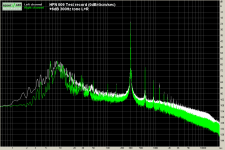 10 S2 t5 Spectrum.png39 KB · Views: 288
10 S2 t5 Spectrum.png39 KB · Views: 288 -
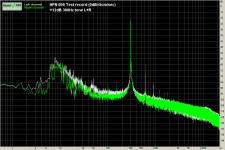 11 S1 t6 Spectrum.png38.3 KB · Views: 293
11 S1 t6 Spectrum.png38.3 KB · Views: 293 -
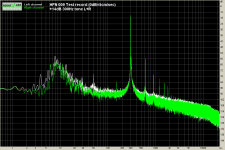 12 S1 t7 Spectrum.png38.4 KB · Views: 285
12 S1 t7 Spectrum.png38.4 KB · Views: 285 -
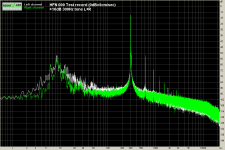 13 S1 t8 Spectrum.png38.7 KB · Views: 282
13 S1 t8 Spectrum.png38.7 KB · Views: 282 -
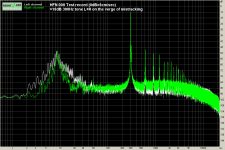 14 S1 t9 Spectrum.png40.1 KB · Views: 286
14 S1 t9 Spectrum.png40.1 KB · Views: 286 -
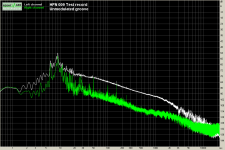 15 S2 t6 Spectrum.png37.9 KB · Views: 45
15 S2 t6 Spectrum.png37.9 KB · Views: 45 -
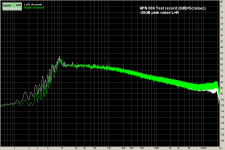 16 S1 t3 Spectrum.png34.1 KB · Views: 52
16 S1 t3 Spectrum.png34.1 KB · Views: 52 -
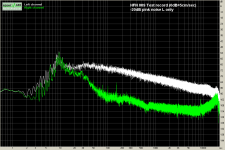 17 S1 t4 Spectrum.png41.1 KB · Views: 51
17 S1 t4 Spectrum.png41.1 KB · Views: 51 -
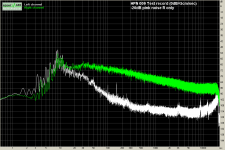 18 S1 t5 Spectrum.png42 KB · Views: 59
18 S1 t5 Spectrum.png42 KB · Views: 59
And it's probably steered by the DC component of the ear's own IMD.Above 80 dB the ear's protection mechanisms begin to kick in.
Some people will hate me now, but I'll do it again.... refer to the IMO groundbreaking paper (plus demo SW) about our hearing mechanisms by Heerens & de Ru :
http://www.diyaudio.com/forums/lounge/200865-sound-quality-vs-measurements-61.html#post2929546
Since that posting I've studied it thoroughly and I find it offers perfect answers for a ton of questions that nobody could answer me before.
Dynamics and aural stimulation
I was sitting in a bookstore coffee shop the other day when someone behind me dropped a metal fork on to the tile floor. The resulting, sharply percussive, dynamic sound event very much startled me. It sounded much like a small bell being struck hard by a metal hammer. The pure loudness level wasn't so much what got my attention as was the accompanying rapid CHANGE in loudness. It wasn't simply that it sounded loud, which it did, but that it's loudness was so sharply brief. Bang, it seemed to appear out of nowhere at full loudness, giving no nervous system warning to the impending acoustic event.
I find live rock music performances, and other amplified performances, to typically sound much louder than live orchestral performances, but not nearly as dynamic. From the perspective of stimulating the human nervous system, orchestral performances seem to be the more aurally stimulating of the two, which is aside from whether I find the music itself interesting. This same principle seems to apply to home audio systems. It's not so much the ability of a home system to produce some high level of perceived loudness - whether by psychoacoustic distortion effects or whatever - that makes the sound aurally stimulating. I feel that it's more the ability of a home audio system to cleanly reproduce the sharply dynamic changes in perceived loudness that natural objects can produce. Whether such objects be a fork hitting a tile floor, or instruments playing in an orchestra. Such an ability is probably why some audio systems can still sound compellingly good at low loudness levels.
The distortion increases with the modulation.
More distortion components= louder perceived sound
Also
More distortion components= more extended higher frequency....
I was sitting in a bookstore coffee shop the other day when someone behind me dropped a metal fork on to the tile floor. The resulting, sharply percussive, dynamic sound event very much startled me. It sounded much like a small bell being struck hard by a metal hammer. The pure loudness level wasn't so much what got my attention as was the accompanying rapid CHANGE in loudness. It wasn't simply that it sounded loud, which it did, but that it's loudness was so sharply brief. Bang, it seemed to appear out of nowhere at full loudness, giving no nervous system warning to the impending acoustic event.
I find live rock music performances, and other amplified performances, to typically sound much louder than live orchestral performances, but not nearly as dynamic. From the perspective of stimulating the human nervous system, orchestral performances seem to be the more aurally stimulating of the two, which is aside from whether I find the music itself interesting. This same principle seems to apply to home audio systems. It's not so much the ability of a home system to produce some high level of perceived loudness - whether by psychoacoustic distortion effects or whatever - that makes the sound aurally stimulating. I feel that it's more the ability of a home audio system to cleanly reproduce the sharply dynamic changes in perceived loudness that natural objects can produce. Whether such objects be a fork hitting a tile floor, or instruments playing in an orchestra. Such an ability is probably why some audio systems can still sound compellingly good at low loudness levels.
Last edited:
Regarding digital vs analog, Lynn Olsen has a great two part article (most of you may be familiar with it already) on why delta sigma DACs are ...not so hot (to be polite about it).
dac
Why is it no one points out that even the best recording mics have several 24bit lsbs of noise in normal application, the preferred VF-14 Neumanns certainly more. Using 16 bit resolution as examples of original source material is rather dated.
Yes, it's the ability of systems to produce 'shocking' contrasts of apparent volume that's a very important ingredient to get right. Many can go loud, but they do in a PA style of overbearing, somewhat aggressive, no holds barred presentation - what's required is for the peak SPLs to roll seemingly effortlessly over you, very sharp transients should instantly 'pierce' your awareness and pass through, almost before you're aware they've occurred.From the perspective of stimulating the human nervous system, orchestral performances seem to be the more aurally stimulating of the two, which is aside from whether I find the music itself interesting. This same principle seems to apply to home audio systems. It's not so much the ability of a home system to produce some high level of perceived loudness - whether by psychoacoustic distortion effects or whatever - that makes the sound aurally stimulating. I feel that it's more the ability of a home audio system to cleanly reproduce the sharply dynamic changes in perceived loudness that natural objects can produce.
IME, low level distortion kills much of this quality in most systems, cleanness of reproduction is paramount - but it's not easy to eliminate these artifacts, irrespective of the cost of the components. However, it is achievable, with the very positive benefit that then the most dreary, "boring" recordings come to life, one understands why the musicians and artists were motivated to put energy into recording the piece ...
Frank,
From my experience I would have to say that the problem attributed to PA sound and we can include the same problem with CD's is the ubiquitous use of compressor/limiters. Everything including the softest passages are pushed up in level to an absurd level and then any loud passages over a specific limit are cut with the limiters really messing up the dynamic range of music. Does a ballad need to be as loud as the loudest passage on a hard driving song, no, but that is what radio stations do all the time. same with many engineers making recordings transferred to cd and most any live event. We need to fight for our rights to dynamic differences in level with popular music. Could you imagine a simple harpsichord being pushed as loud as a saxophone, it doesn't do the music justice. So those recordings that would make you jump if recorded well just don't have that dynamic impact when all the levels are brought so close together that they all have the same impact.
From my experience I would have to say that the problem attributed to PA sound and we can include the same problem with CD's is the ubiquitous use of compressor/limiters. Everything including the softest passages are pushed up in level to an absurd level and then any loud passages over a specific limit are cut with the limiters really messing up the dynamic range of music. Does a ballad need to be as loud as the loudest passage on a hard driving song, no, but that is what radio stations do all the time. same with many engineers making recordings transferred to cd and most any live event. We need to fight for our rights to dynamic differences in level with popular music. Could you imagine a simple harpsichord being pushed as loud as a saxophone, it doesn't do the music justice. So those recordings that would make you jump if recorded well just don't have that dynamic impact when all the levels are brought so close together that they all have the same impact.
Above 80 dB the ear's protection mechanisms begin to kick in.
Yeah, the tensor tympani muscle tries to protect the ear from loud sounds.
It was the distortion increasing perceived dynamic range I was curious about. But, gpapag kind of answered that.
I prefer the sound of high-res digital to LP anyway. Sounds more real to me. Big recording companies don't see much of a market for it unfortunately.
John
Why is it no one points out that even the best recording mics have several 24bit lsbs of noise in normal application, the preferred VF-14 Neumanns certainly more.
Perhaps they don't point this out because they see no relevance. The issue with the S-D DACs is not the noise floor in absence of signal (that's demonstrably fine), but rather the variation of noise with signal level. Noise modulation in other words. If your Neumanns have noise modulation I'd be curious to know the mechanism.
I heard a report recently that the big thing in smartphones in 2014 will be hi res audio. This may not be hi end hi res but I think just getting the idea out there in the public awareness that hi res audio exists and sounds better seems like a step in the right direction - might even become fashionable.
Exactly so ... standard 16/44.1 has all that's needed, I have yet to see anything that shows value in going to "better" formats. Some hardware performs at a higher level if fed with material encoded at a 'higher resolution' - if that's the case, simply resample to the hi-res format before playing, costs nothing but storage space ...
Exactly so ... standard 16/44.1 has all that's needed
I really do not think so.
Because if you step up to 88 or 96kb/s or higher the design of the filters becomes so much easier. It just gives the designer room to work
16 bit may be OK for the final product but it would greatly restrict digital mixing.
But, higher sampling rate and greater bit depth is not a magic bullet - I'm sure there will still be good & bad recordings just as there are now.
16 bit may be OK for the final product but it would greatly restrict digital mixing.
But, higher sampling rate and greater bit depth is not a magic bullet - I'm sure there will still be good & bad recordings just as there are now.
I was talking of the final product, how it's distributed - of course, in the recording and editing phase extra headroom in every dimension is always valuable, even essential.
Higher sampling rates can always be utilised at the reproduction end, and effectively that's what usually happens, by one means or another. But in terms of capturing the content of the final mix, and transporting all of that data to its destination, 16/44.1 is perfectly adequate ...
Edit: my point is, that all the information is on the CDs right now, going right back to the earliest examples, for reproduction to work at the highest levels of quality - it's the vinyl story all over again, the 'grooves' have captured all the necessary information, but often the listener is not hearing all parts of the message.
Higher sampling rates can always be utilised at the reproduction end, and effectively that's what usually happens, by one means or another. But in terms of capturing the content of the final mix, and transporting all of that data to its destination, 16/44.1 is perfectly adequate ...
Edit: my point is, that all the information is on the CDs right now, going right back to the earliest examples, for reproduction to work at the highest levels of quality - it's the vinyl story all over again, the 'grooves' have captured all the necessary information, but often the listener is not hearing all parts of the message.
Last edited:
I do notice that if a movie is made in high definition, even if you buy the DVD version ( rather than the bluray ), you still can notice the extra quality.
I agree that a really good recordings - like Ry Cooder's world music collaborations - can sound very good in 16/44.
For me it's just a pity that really good recording seem to be so rare. For some reason world music, jazz & movie sound tracks seem to be generally recorded better.
I think having Mr & Mrs Jo public buying hi def audio enabled smartphones and enjoying the music thereon is a good step in raising public awareness that music reproduction can be better. In this environment poor recording will be more evident and hopefully that will raised the standard.
I agree that a really good recordings - like Ry Cooder's world music collaborations - can sound very good in 16/44.
For me it's just a pity that really good recording seem to be so rare. For some reason world music, jazz & movie sound tracks seem to be generally recorded better.
I think having Mr & Mrs Jo public buying hi def audio enabled smartphones and enjoying the music thereon is a good step in raising public awareness that music reproduction can be better. In this environment poor recording will be more evident and hopefully that will raised the standard.
Last edited:
- Status
- Not open for further replies.
- Home
- Member Areas
- The Lounge
- John Curl's Blowtorch preamplifier part II